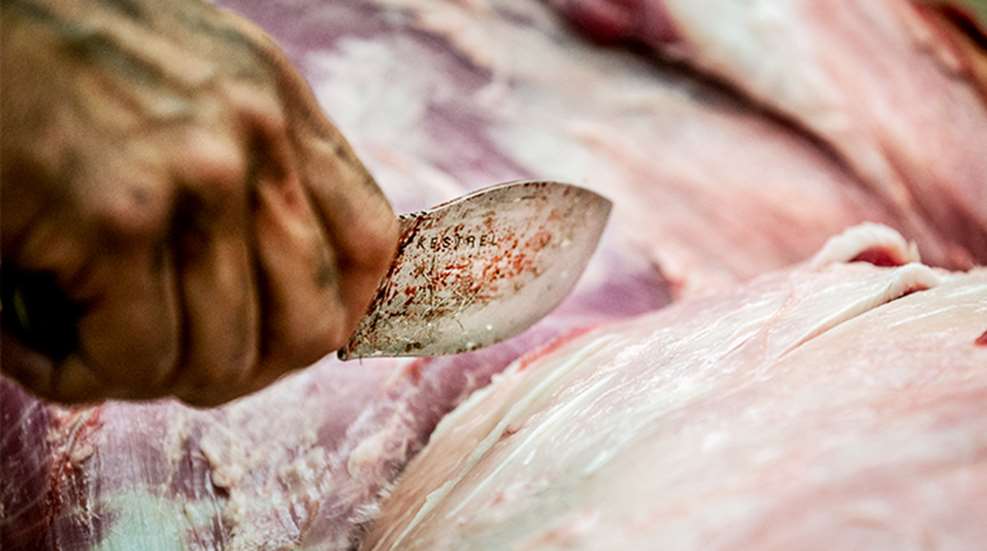
A torrent of emotions was flooding my nervous system as I watched the bull elk topple into the decaying branches of the deadfall a mere 60 yards away. I paused to treasure the specialness of the rare moment in time while hunting public land in Wyoming on a solo, do-it-yourself hunt. Success is never a guarantee.
Experiences like this should be savored, but the real celebration would have to wait. It was early September and I had dropped more than 3,000 feet in elevation to find elk. The date, combined with the elevation drop, erased any factor the cool air of the high mountains might play with my situation. Temperatures were above 60 degrees. Meat needed to be dealt with ASAP.
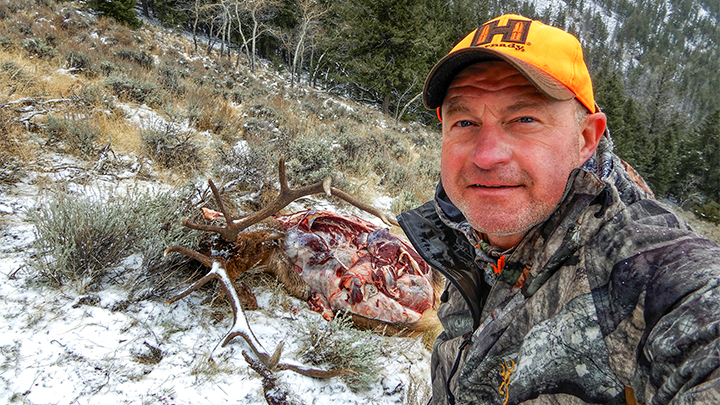
The lifeless form jammed into the limbs and trunk of the tree added another element of difficulty to the job ahead. I took one last look at the massive animal before me then rolled up my sleeves for a lengthy shift in the forest butcher shop. The afternoon was about to turn into an extreme meat extraction event.
When you break hunting down to its purest form, it’s about meat. Most of us hope to see a trophy buck or bull pass in front of our sights, but we are also realistic; before the season closes a plump doe will eat just fine. Now, after the COVID-19 pandemic of 2020, an extra doe or two in the freezer always seems like a good idea.
To ensure your dining entourage enjoys the venison you retrieve from nature’s paddock, you need to be prepared to extricate the bounty in any environment imaginable. Landscape hurdles, climatic conditions and contaminates in the surroundings all could add to the extremeness of the experience. You spend hours prepping your hunting gear. Make sure you spend equal time formulating a plan for meat recovery in an extreme situation.
I Can’t Take the Heat
Heat is the likeliest of all extreme conditions you’ll encounter. It can ruin meat in hours if you don’t have a plan. Whether you’re hunting August deer seasons in South Carolina, Kansas’ September muzzleloader season or taking part in a Western pronghorn hunt in the early season, T-shirt temperatures and meat don’t play together well. In any situation where temperatures rise above 40 degrees, speed is essential for flavorsome filets later.
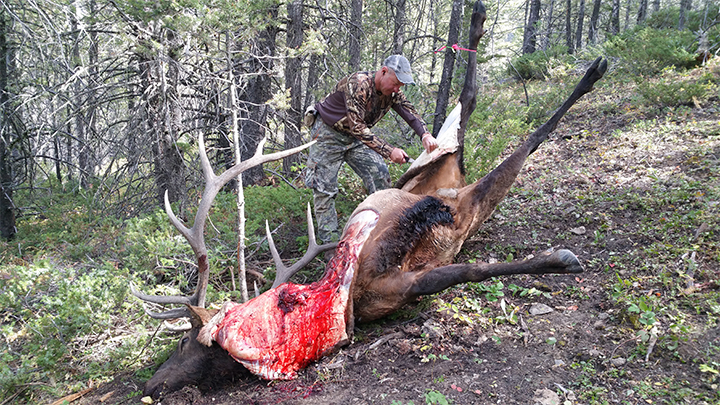
One August morning I was bowhunting pronghorn from a ground blind and a decent buck watered at sunrise. My aim was spot on and the buck tipped over in a futile dash. By the time I had field-dressed the buck, dragged it to my ATV and returned to camp, the temperature was nearing 80. I promptly skinned, quartered and stowed the meat portions in a cooler stocked with ice before the noontime whistle. Because of this speed, my family relishes pronghorn anytime over deer and on par with delectable elk.
Bacteria are the enemy in any meat situation. According to the Pennsylvania State University College of Agricultural Sciences Penn State Extension office, bacteria grow even in temperatures below 40. Even so, above 40 is the range you need to be concerned with most. Informative meat-handling instructions on their website clarify this potential danger: “Bacteria grow most rapidly in the range of temperatures between 40°F and 140°F, in some cases doubling in number every 20 minutes. This range of temperatures is often called the ‘temperature danger zone.’”
There are several consequences to handling game meat poorly at this time: foodborne illnesses, spoilage, bacteria, yeasts and mold can invade meat exposed to above-freezing temperatures too long. In brief, this can cause meat to have a tainted flavor, be dangerous to consume or even outright ruin it.
Bacteria are the enemy in any meat situation. Bacteria grow even in temperatures below 40.
Before you leave on any hunt with temperatures exceeding freezing, outline a strategy to beat the heat. First, consider storage or meat locker options. Check with local lockers for their hours of operation and even seasonal openings. Some rural livestock meat processors double as wild game processors, but due to regulations they shut down commercial livestock butchering to take in game. They may not accept wild game prior to a major season opening like rifle deer.
At home or in camp, make sure freezers or refrigerators are operational, clean and have space to accommodate possible success. There’s nothing more frustrating than arriving at deer camp and opening an old freezer to be met with a disgusting odor or a unit that doesn’t begin humming when plugged in.
Hunting camps should include enough quality coolers to hold anticipated success. Stock these with blocks of ice, not cubes of ice. Blocks last longer, especially if you don’t open lids. My hunting pal Levi Duncan suggested to me one elk season to use frozen, water-filled milk jugs. When they thaw you also have a reserve of potable water that can come in handy for a variety of uses including drinking, meat cleaning and after-hunt splash baths.
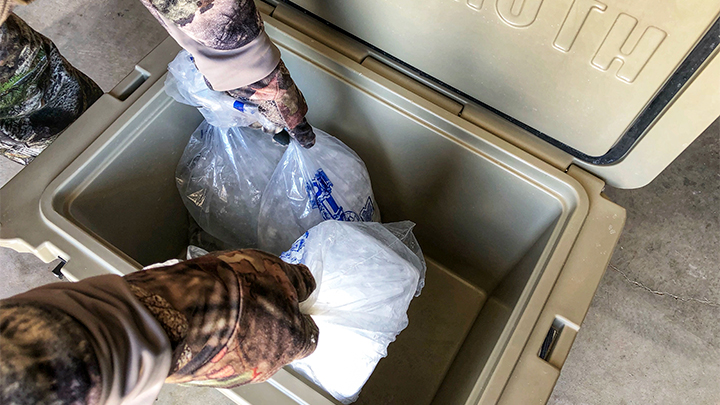
You must think fast at the kill site. Prompt field-dressing removes a huge heat source and allows meat to cool faster. You may wish to leave the hide on to protect meat while dragging or transporting an animal, but in temperatures above 50 it pays to remove the hide soon after to accelerate the cooling of game.
Some extractions in rugged backcountry may require you to skin the animal, break it into manageable parts and possibly debone all meat. Prepare by packing along game bags constructed of cotton, canvas or even new composite options such as Cabela’s antimicrobial game bags. The open weave allows air to chill meat while protecting it from insect invasions and forest duff.
To assist in cooling, especially if you can only take out one load at a time, stash meat in natural “cooler” locations. While preparing elk for extraction, I stack meat bags on logs in shade to allow cooling air to circulate around pieces. I’ve even created log decks over spring-fed streams to lay meat on them in shadowy, cool recesses while I haul several loads with the backpack.
In some case, such as when you face a two-hour drive home in high temperatures, you may fill the body cavity with ice and rope it shut. It’s not ideal, but any chill helps until you can get the animal to your processing and cooling destination.
Whatever you do, don’t tie the animal to the roof or hood of your vehicle. And for the sake of delectable backstrap steaks, minimize your stops around town to show off a trophy. That’s what Facebook is for … besides snooping!
Make Mine Boneless
It was the third deer I had killed across a river in a roadless section of a South Dakota ranch. My first two recoveries were as floundering as the first time I tried to kiss a girl, but the third time was a charm and I was more than prepared to pack out the buck in quarters. Every deer hunt doesn’t end with you backing up a truck to a buck in a cornfield or putting a deer on a wheeled cart for a bouncy ride out. Some extreme locations require you to pack out a deer or elk on your back.
Can you handle the job? Be honest. Anyone with weak knees or ACL issues and anyone carrying an extra 50 pounds (or more) of fast food could find it difficult. The packing job could be miserable, if not life-threatening.
When you do the math, even a medium-sized deer that has been deboned ends up as a 60-pound load of meat. Meat processers will tell you to expect 35 percent of the animal’s live weight after you debone it with precision. Antlers and a cape add even more, and may require a second pack load, especially for elk. Leave the bones in your deer and your load could exceed 100 pounds. Even that extra, deboned doe will average 45 pounds of meat in your pack. These tallies don’t consider your hunting gear that adds to the total.
If this is an elk hunt, an Aleve ending is guaranteed. You will undoubtedly want to debone an elk unless you have a camp full of hardy friends. You need to subtract extra weight. It can become an extreme burden when miles, not yards, of packing are required to transport meat to your iced coolers.
When you debone a bull elk the pile of meat in bags could exceed 250 pounds. With antlers and a skull your tally could easily hit 300 pounds. Even a big cow results in more than 100 pounds of deboned meat. If taxidermy is in the future, a heavy, wet cape and antlers is a trip in itself depending on the trophy size.
For elk it pays to study the gutless method of meat removal to save time (see “The Smart Way to Pack Out Elk”). Taking out the guts does cool meat faster, but it is time consuming and generally not needed. Just skin the hide away from quarters and follow muscle groups to filet away future meals. Put meat directly into your game bags to eliminate contamination and allow air to circulate around those bags for the cool-down.
Do not forget to remove the inside loins. After removing the backstrap and rear quarter, move to the rear quarter location and make a careful slit underneath the backbone forward of the quarter. Reach in and gently filet the inside loin from the carcass. With a slight tug it will easily detach. Mmm!
Deboning a deer or elk sounds extreme, but it may be necessary thanks to the landscape, as in the case of the elk I bowkilled in the beginning. His 700-plus-pound body jammed up against the fallen log forcing me into some creative carving to remove meat by myself. Last year I shot an elk on a near-vertical slope and at the shot he cartwheeled more than 100 yards straight down the slope. I deboned half of him and was flopping him over when he decided to continue the Space Mountain, downhill joyride. He stopped after another 80 yards of sledding and this time I used every inch of paracord I had to lash him to three different sagebrush clumps to hold him in place as I completed the butchering.
Other overlooked items in an extreme extraction include hiking staffs to help you stabilize while hiking under weight in rugged terrain. Always have at least two light sources and extra batteries to illuminate your workspace and your path while hiking. And don’t forget to have your track plotted on your hunting app or GPS. There’s nothing more comforting to me than to look down at my HuntStand hunting app glowing in the dark with a brightly blazed trail back to civilization. In addition to these items, stow all necessary survival and first-aid items in your pack to ensure your survival in an emergency.
We’re Going to Need Our Galoshes
Even though you may not have to pack 100 pounds of meat down a snow-packed mountain, it’s not uncommon to recover a deer in extremely mucked-up conditions. For meat to be appreciated it needs to be as meticulously clean as possible. Mud, sand, dirt, murky water, vegetation and other pollutants of the natural world have the capacity to ruin the flavor of your venison. Do you want sneers or praise for a marinated venison roast? Keep it clean.
According to online information by Barbara Ingham, a food science specialist for the University of Wisconsin-Extension, there are three considerations to follow when working with venison.
“The key points when handling venison are: 1) keep it clean; 2) keep it dry; and 3) keep it cold," says Ingham.
The earlier discussion about using the animal’s hide to protect meat should be your first consideration. Unless you’re deboning to pack out an animal or you’re hunting in jungle-hot conditions, it’s perfectly fine to leave the hide on during retrieval. It protects nearly the entire carcass from the gunk you might drag an animal through during recovery. Use antlers, a rope or a deer drag to pull the deer back to your vehicle. Go slow. Look ahead for obstacles and be watchful not to trip and accidentally stab yourself on an antler.
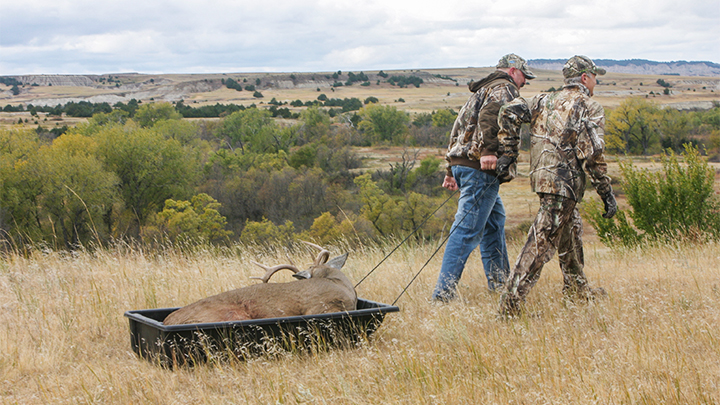
Even if you must wade an animal across questionable waters, like a stagnant bog, the animal’s natural tendency to float, along with the hide, will keep most of the nastiness away if you balance it on its back. The hide also serves as a barrier to any noxious unpleasantries rolling around in the back of your pickup truck like that tipped diesel fuel container. When you arrive at home or camp, hang the deer and skin off the hide if appropriate for final cooling. In most normal hunting temperatures, you can leave the hide on for hours, if not several days if temperatures stay below 40, but it’s always easier to skin a warm carcass.
Conditions might warrant additional protection. In that case turn to Tractor Supply for a $10 tarp. Lash it around your deer before the drag out or to keep road grime off the carcass during transportation. It’s another protective layer against dirt, mud, dust, leaves, truck bed toxins and insects. You can also use a sled to skid a deer out while riding it above the noxiousness of nature. Farm- and ranch-supply stores sell these for just this purpose in addition to hauling bales and other ag uses.
Challenging hunts in intense environments add up to extreme meat retrieval. I shot my elk at 10 a.m. and finished the recovery well after sunset. Being prepared helped tame the extremeness and my family later enjoyed the best table fare nature has to offer due to some prudent planning.
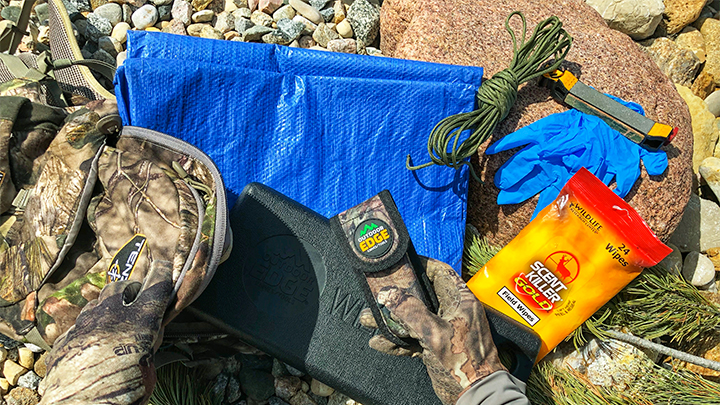
Gear to Tame the Extreme
• Backpack capable of comfortably handling 100-pound loads: basspro.com
• Sharp knives: outdooredge.com
• Lightweight sharpener
• Folding saw (optional, but can be used to saw antler skull caps)
• Paracord, 20 feet or more
• Latex gloves (2 pair) and long gutting gloves
• Field wipes and paper towels: wildlife.com
• Game bags if you are quartering or deboning in the field: koolabuck.com
• Unscented garbage bags for miscellaneous and backpack liners
• Ziploc storage bags for inside loins, heart
• Water for drinking and cleaning any accidental spills on meat
• Light—two sources plus backup batteries
• Hunting app downloaded on your phone: huntstand.com
• Hiking or trekking pole(s): leupoldshop.com
• First aid and survival gear: cabelas.com
• Coolers full of ice at camp
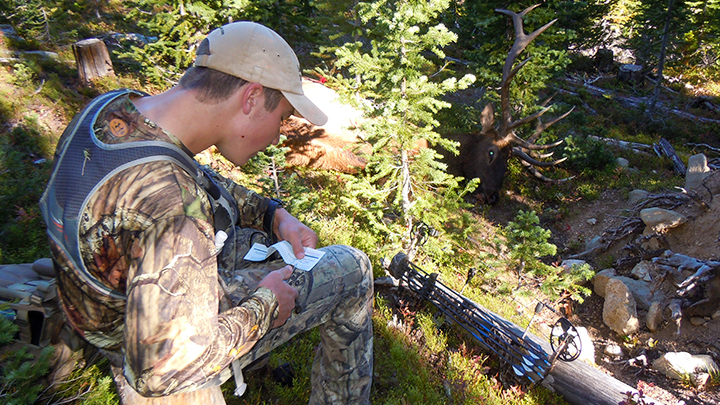
Know the Rules
Educate yourself on all laws regarding evidence of sex and how much meat is required by law to be recovered. Tag your animal in accordance with regulations. Pay special attention to all chronic wasting disease regulations and transportation protocols. Most states now have laws barring the transportation of heads with brains, spinal columns and even whole, unprocessed carcasses. To learn more about your local regs, click here.




































